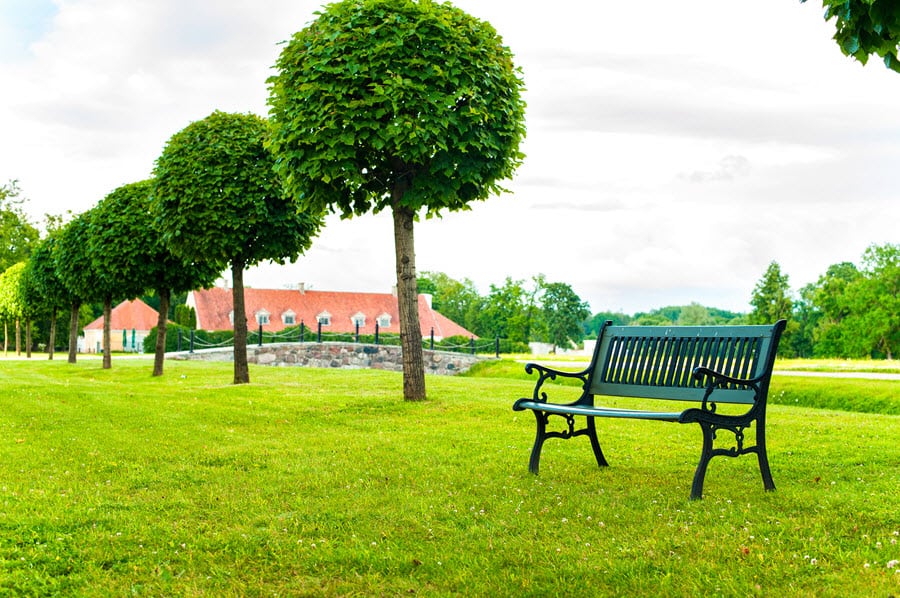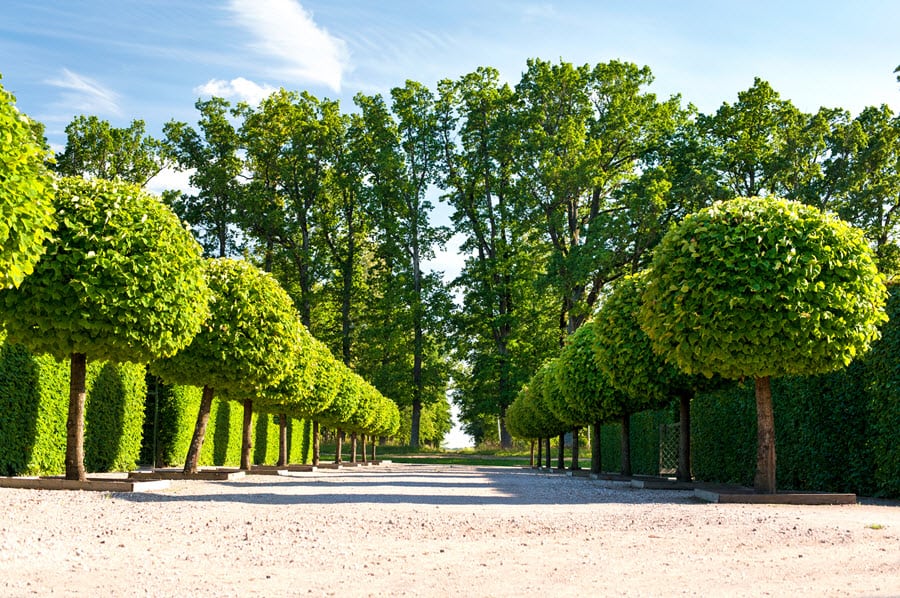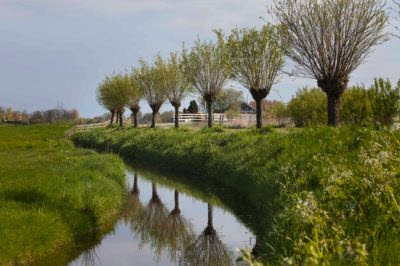
As you begin to read more about pruning techniques you will see a variety of terms, including pollarding. This can become confusing, especially if the terms are used interchangeably in an article and you may find yourself asking what is the difference between pruning and pollarding?
What Is The Difference Between Pruning And Pollarding? Pruning is the general term for cutting tree limbs in order to control growth. Pollarding is a specific form of pruning which involves cutting branches back, almost to the trunk in order to produce a dense, ball-shaped canopy. It is most often used when there is limited space for a mature tree.
So, how are these “lollipop” trees created? Why are some trees trimmed in this way? And when did pollarding begin? The answers to these questions and more are coming right up.
What Is Pollarding?
Pollarding is a very specific pruning technique which has been in use for centuries. To “pollard” a tree you cut all of the branches, and the central leader of the tree back, to within a few feet of the crown. Traditionally this was done at a height of approximately six feet from ground level, but today the point at which the “ball” of branches sits varies according to the wants and needs of the tree owner.
How Do You Pollard A Tree?
If you wish to pollard a young tree, you should wait until it has reached your desired height. Then, when the tree is dormant you choose either three or five branches that will remain. These branches will be the ones from which the new growth will appear. Cut the chosen branches back until they are approximately a foot long. In addition, remove any side shoots at lower levels of the tree.
When you choose to pollard an established tree the basic technique is the same. You choose three to five branches to form the base of your pollard, and cut back everything else, being sure to remove the central leader of the tree. Again, it is also important to remove any growth below your “pollard head.”
In the first year of growth, you will see twiggy stems growing from the within the tree bark. This growth can have a weak attachment to the tree and is more vulnerable to weather damage during its first year.
As the tree ages and lays down its annual growth rings, a thicker attachment is established where the stem and the branch meet, makiing the stems stronger as they age. Eventually these layers of ring growth form a bulb at the end of the branch stump and it is from this ball that future stems will grow.
Maintaining A Pollarded Tree
Once a tree has been pollarded it is important to maintain a regular cycle of pruning, using the pollarding technique.
To do this you should cut the three to five branches of choice back to just above the point of the previous pollard cut. Leave the growth which has sprouted from the end of the cut branches intact. As the tree ages, in order to maintain the look of your tree, you will thin out the stems which are sprouting from the ball on the branch stump.
Maintenance pollarding should be carried out at a time when the tree is dormant, during the winter or early spring, depending on the species. The exception to this is the maple tree. If you prune the maple during this time you will be doing so while the sap is running and end up with you, your tools, and your tree covered in a sticky sappy mess.
If you are pollarding in order to keep your tree a particular size, then this pruning technique should be applied every other year. On the other hand, if you are pollarding for wood, to maintain an existing pollarded tree, or for purely aesthetic purposes then once every five years is a good rule of thumb.
In the meantime, during the pruning window on “off years,” and in fact throughout the year, keep an eye on your pollarded tree and remove any broken, diseased, or dead branches as soon as you spot them.
What Happens If You Stop Pollarding?
If you were to stop pollarding a tree which has been previously pruned in this way, a number of things can happen:
- The branches become excessively heavy and prone to breakage.
- The crown of the tree becomes extremely dense and can lead to:
- Excess humidity which can result in disease
- Overcrowding of branches
- A lack of light reaching the ground below the crown and, as a consequence, the death of other plants around the tree.
Rejuvenating An Overgrown Pollarded Tree
If you wish to restore an overgrown pollarded tree to its former glory, you may be better off calling on the services of an expert arborist.
However, if you want to try the rejuvenation yourself then you should start by identifying the species of the tree as different species should be rejuvenated in different ways.
For example, a London plane tree should be rejuvenated as follows:
Begin by attempting to identify which branches were the ones which were origionally pollarded. If you can tell which branches these were, then cut back everything else on the tree, remove all side shoots, stems, and branches. Leave the “balls” on the end of the branches which were pollarded and any stems which are growing from it. Depending on the number and thickness of the stems, you may then wish to thin these out.
Meanwhile, if you have a horse chestnut you should establish a pollarding point above the original pollarded crown and begin the pollarding process as if you were pruning a tree from scratch.
Finally, other trees, such as the oak, benefit from a mixed approach, a kind of staggard pollarding which leaves an existing branch but creates new pollarded branches above this point.
Why Is Pollarding Used – Modern Uses?

The most common reason for pollarding trees today is to maintain them at a specific height. By pruning trees in this way in urban areas, limbs can be prevented from encroaching on powerlines or buildings, leaf loss in the fall is kept at a reasonably consistent level, and root systems are less likely to cause issues by breaking up hard surfaces.
However, that’s not the only reason.
- Some gardeners choose to pollard a tree because they have a limited space in which it can grow.
- Tress which are casting excessive shade and thus limiting or preventing growth below them may be pollarded in order to let more light into an area of a garden.
- Occasionally a tree will have a special significance to a community or to an individual. In this situation, pruning the tree with the technique of pollarding can allow a tree which might otherwise have to be removed, to remain.
Why Was Pollarding Used – Historic Uses?
Nobody knows for sure when the pruning technique of pollarding was first developed. However, we do know that there are mentions of its use in ancient Rome and that pollarding was in use across Europe during the medieval period.
Trees were pruned by pollarding not for aesthetic purposes but for animal feed, for wood, and for construction materials. Pollarding encourages new growth and by keeping the trees in this semi-juvenile state they could be cut back for animal fodder every two to six years, depending on the species of tree. The leafy branches were cut in the summer and dried. These would then be used over the winter, to feed livestock.
Eventually, this technique would result in a tree which was significantly more woody then leafy and it would no longer be useful for animal fodder. When this happened the pollard was finally cut down, a new tree was planted, and the cycle began again.
Some trees were pollarded not for livestock feed, but in order to harvest their wood. The branches from trees which have been pruned with the pollarding technique have a tendency to be straighter than those from unpruned trees and this made them popular for fences, home framing, and other building uses. Pollarding for wood was also used for fuel, and to produce charcoal for industrial processes.

Finally, some trees, such as the willow, were a popular candidate for pollarding as by pruning the tree in this way you could harvest an abundant supply of stems for weaving, without having to cut down the tree, replant, and wait for it to grow large enough to harvest again.
By pollarding a tree you can harvest wood or fodder from it for decades instead of cutting it down and waiting for a new tree to grow. In fact, some trees maintained in this way have become so old that they became hollow inside and as a consequence are almost impossible to accurately age.
In addition pollarding was a popular pruning technique because it allowed more light to fall on the ground around the trees. This, in turn, enabled the landowners, or renters, to grow other crops under pollarded trees and doubling the yield from one piece of land.
So it turns out that by developing the pruning technique of pollarding, our ancestors were actually developing the “art” of agro-forestry and carrying out some of the earliest sustainable practices.
Positive Side Effects Pollarding
I have already mentioned the fact that pollarded trees have a significantly longer life span than that of their unpruned counterparts. An excellent example of this is the beech tree. Planted in the UK and either left to their own devices or pruned in other ways, beech trees live for an average of 200-250 years.
Meanwhile.
A beech planted at the same time, in the same soil conditions and maintained by pollarding can be expected to live well over 500 years.
A Haven For Wildlife
This side-effect of pollarding may be positive for those who wish to promote biodiversity but for those who are interested in the healthiest tree possible, not so much.
Through regular pollarding trees may develop multiple tiny niches or small decay pockets. These little chambers can become filled with water, sap, and teeny pieces of bark, leaf, and other debris. Then, these pockets of detritus can become an oasis for flies, beetles and other insects.
Where you find insects you also find those animals and birds which feed upon them and as a pollarded tree becomes older, and develops more crevices bats, birds, and even small mammals may find their homes within it.
Of course, this is an advantage only if the tree is not damaged by wildlife or any diseases which may take root through those same niches, cracks, and divots.
But worry not.
This usually only happens in situations where a larger area of trees are being pruned by pollarding and when the trees become significantly older. Unless you have inherited a pollard tree which is in the centuries-old range, it is unlikely to be something you need to worry about.
Species Which Can Be Successfully Pollarded
Not every tree species is a suitable candidate for pollarding. From a technical standpoint, only those trees which have vigorous epicormic growth can be pollarded.
What Is Epicormic Growth?
The short explanation is:
Trees which experience epicormic growth have multiple dormant buds under their bark. When the upper branches and leaves are intentionally removed or lost through natural causes, these buds, in the lower part of the tree, begin growing. As a result, the tree survives because it can regenerate branches and leaves.
If a tree of a species without these buds under its bark loses the crown, it will die because the tree will no longer have branches and leaves through which to process sunlight.
However, although a pollard must have epicormic growth, not every species with epicormic growth makes a good pollard. This is because, in some species, cutting the upper branches back will stimulate growth, but this growth will sprout at the base of the trunk and not from the end of a branch.
Which Trees Do Wells As Pollards?
If you are looking for a tree species to pollard from scratch or if you are wondering if a tree you currently have would be suitable for pollarding, the most suitable species are:
- Ash (Fraxinus)
- Beeches (Fagus)
- Black locust – also known as false acacia (Robinia pseudoacacia)
- Common lime (Tilia × Europaea)
- Elder (Sambucus)
- Elm (Ulmus)
- Eastern redbud (Cercis canadensis)
- Gum (Eucalyptus)
- Hornbeams (Carpinus)
- Horsechestnut (Aesculus)
- Lindens and limes (Tilia)
- Maple (Acer)
- Mulberries (Morus)
- Oak (Quercus)
- Planes (Platanus)
- Redbud (Cercis)
- Tree of heaven (Ailanthus altissima)
- Tulip tree (Liriodendron)
- Willows (Salix)
- Yew (Taxus)
Generally speaking, conifers do not make good pollards but just as with every rule, to this, there is an exception. Yews (Taxus) can make excellent pollards.
Why Is It Called Pollarding?
Originally, the word “poll” meant the top of the head and the verb “to poll” meant to crop the hair on top of the head.
The word was eventually also used to mean the trimming of the tips of animal horns and the cutting off of the top of a tree.
In the same way that someone who was drunk was called a drunkard, someone, or something which was polled was referred to as a pollard. Eventually, the noun pollard was used as a verb and, in forestry, has replaced the use of the word polled, although you may still find this use of the word in older texts.
Conclusion
So, in conclusion, if you are wondering what’s the difference between pruning and pollarding, it is that pruning is a term for a range of cutting and trimming techniques while pollarding is a particular pruning technique. Pollarding is used to produce a dense, ball-shaped crown on a tree. It is often used with the intention of restricting the size of the tree due to a limited amount of space or in order to prevent the tree encroaching on other spaces.
